A Beginner’s Guide to Formula One
Formula One is one of the fastest sports in the world and includes a lot of rules and facts. Whether you are a beginner who’s never seen Formula One (or F1 for short) or a casual fan who watches it from time to time, this article can come in handy if you want to understand it better.
Racing cars can achieve a maximum speed of 375 kilometers per hour (235 mph) but it’s not all about the speed. It’s about strategy as well, and 5-Minute Crafts will show you that in this guide.
History of Formula One
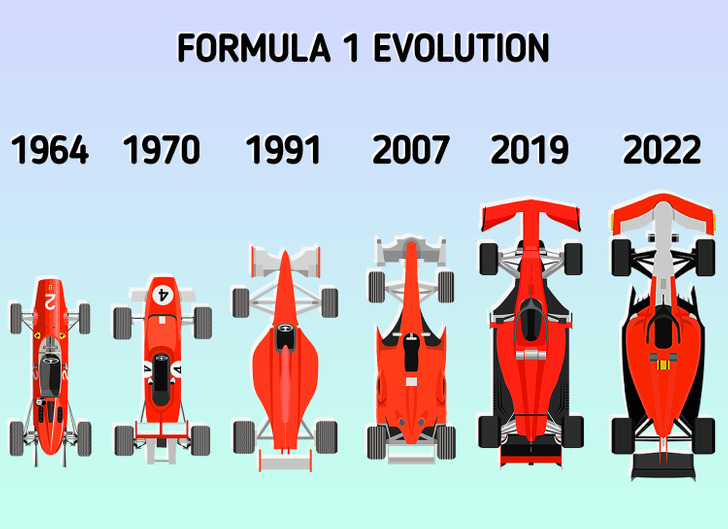
Formula One started to develop in the 1920s and 1930s along with the European Championship of Grand Prix races. At first, there were no limitations on the size and power of the cars which resulted in the serious injuries of the participants. Soon afterward, new sets of regulations were introduced. The first non-championship race took place in Turin, Italy in 1946, while the first championship race was held in 1950, in Silverstone, UK, and this was considered to be the inaugural season.
In 1958, the Constructor Championships were also launched. There, the corporation or the person who is the most successful constructor of the engine or chassis gets rewarded. Teams can work together on this and they each own the intellectual rights to it. For example, the McLaren-Renault team, where the chassis is built by McLaren and the engine by Renault that are suited for tracks and drivers.
Formula One Overview
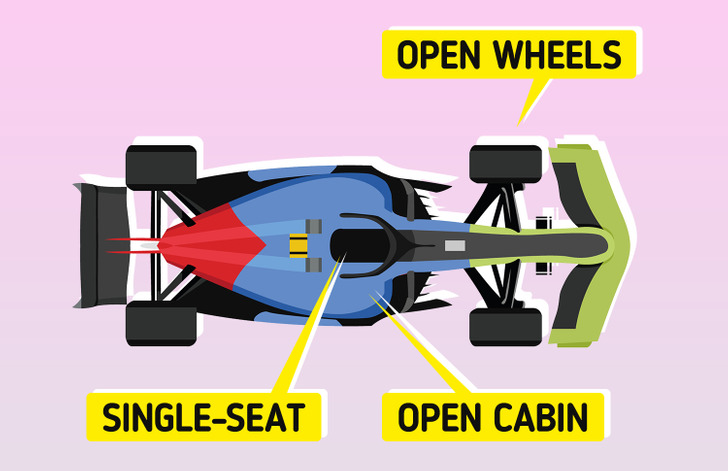
Formula One is the highest-class racing event held in a series across the world. The drivers compete in open-wheel, open-cabin, single-seated cars with 4 wheels and they all have to abide by different sets of rules. The word ’Formula’ actually refers to the rules that all members of F1 need to follow (drivers, constructors, mechanics, etc.). The word “One” specifies that this is the ultimate formula racing (there are also F2 and F3) and that is different from street racing.
The rules were introduced by FIA (Federation Internationale de l’Automobile) and they include limits on the size and power of the cars so that fair play can be ensured for all participants.
Formula One consists of seasons, also known as Grand Prix. The number of Grand Prix can vary, but there are usually from 19 to 20 per year. In 2022, however, a record-breaking number of races are scheduled — 23 in total.
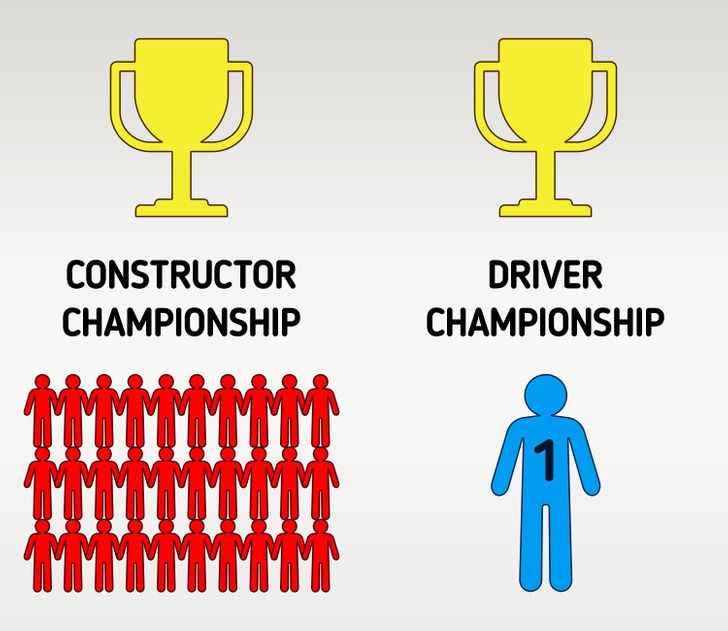
This is a team sport and each team has 2 cars. Since there are 10 teams that means that there are 20 race cars competing for a prize. Even though 2 drivers can be on the same team, they are also competing against each other.
Each race is held on a different track and all of them are different. Drivers collect points in each race and at the end of the season, there are 2 trophies — the Constructor Championship and the Driver Championship (more about the Championship and point systems in the following sections).
Season layout
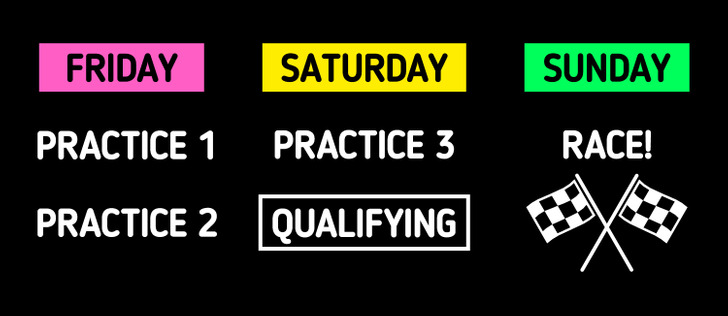
Every year, before the start of the season, FIA announces the race calendar with the dates and places where the competition will be held.
The race is organized over 3 days — Friday, Saturday, and Sunday. On Friday, 2 practice sessions are held so the teams can test the cars, and drivers can learn the circuit and check to see if the vehicles are working properly. The third practice takes place on Saturday when they compare the data from the previous day and see if the changes they made were effective. Also, the qualifying is held the same day, after the third practice. Sunday is the big race day.
Qualifying

Qualifying sessions are very important and are held on Saturday afternoons. This will determine the grid position of the car or the place where the cars line up before the beginning of the race. It’s the opportunity for the drivers to get the best starting position.
Qualifying sessions are broken into 3 sessions:
- Q1 — all drivers take laps for 17 minutes and post their quickest lap time.
- Q2 — the top 15 drivers from the previous session have 15 minutes to produce their best time.
- Q3 — the best 10 drivers from Qualifying 2 have now 10 minutes to get the fastest time and fight for the pole position.
So, in essence, the quickest driver will be first, at the start (he will have the pole position) and the slowest starts race at the back of the grid. The person with the pole position has the highest chance of winning the race.
Race
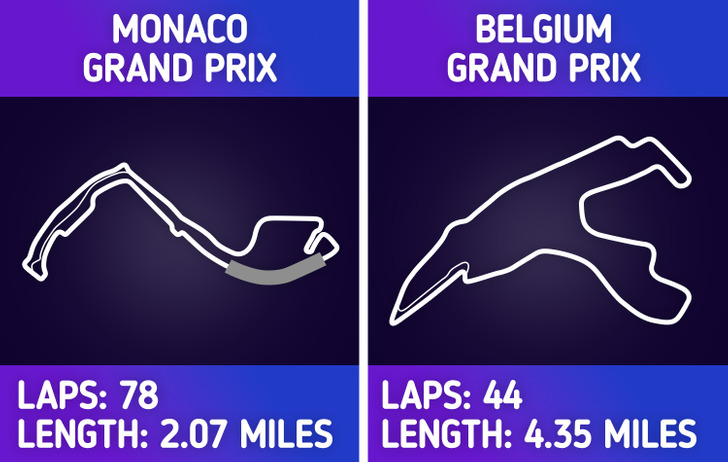
The day after the qualifying, drivers get ready for the race or Grand Prix. They come out early to grid up while their teams assess them and they do a warm-up lap behind the safety car. After they complete the warm-up lap, drivers get into the initial grid slots and wait for the signal lights, and then the race begins.
The length isn’t determined by laps — the average distance of a circuit is 190 miles (305 km). One round around the circuit counts as one lap and there are different numbers of laps for different circuits.
Each circuit has a different length per lap which affects the number of laps. For example, Belgium has 44 laps, while Monaco, one of the shortest circuits, has up to 78 laps in one Grand Prix. The average time that the race could take is 2 hours.
At the end of the race, the checkered flag is shown, and the drivers do a cool-down lap. Once they are finished they go to the pit. Then, the top 3 drivers who finished the race enter the podium and are awarded trophies and points, fourth to 10th get points too, but the rest of the grid doesn’t get any points or rewards.
Championship (Points system)
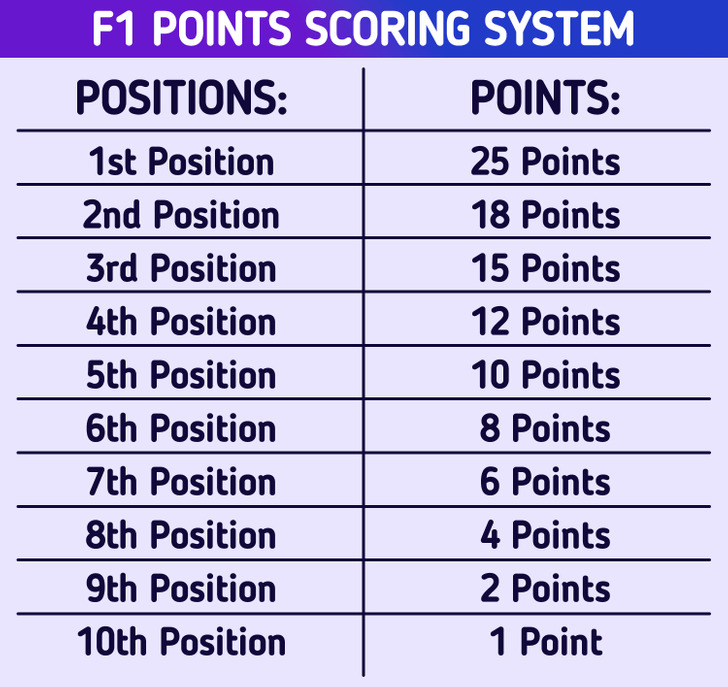
As mentioned before, there are 2 World Championships — the Constructor (for the team) and the Driver Championship. Both are won by scoring points during the races in the season.
- Note: One additional point goes to the team and the driver for the fastest lap. The winner of the championship is the driver (or the team) with the most points. If there is a tie and 2 competitors have the same amount of points, then the first place goes to the one who has the most wins.
Rules and regulations
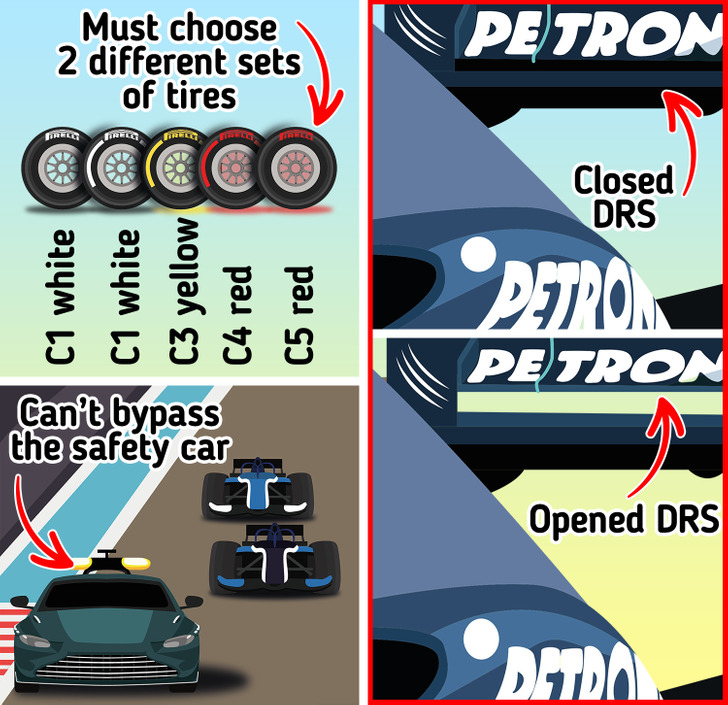
Some of the basic rules of Formula One:
- Cars are obligated to make at least one pit stop during the race. Also, the drivers must manage the fuel well and start the race with a full tank since refueling during the race is not allowed.
- They have to use at least 2 types of tires during the race, which is why they have to make at least one pit stop — to change tires.
- In case of a crash, the safety car is brought out that goes in front of the circuit and race cars line up behind it. Race cars cannot pass the safety car and they need to slow down their speed until the debris is cleared and the track is safe for racing again.
- Use of the DRS (Drag Reduction System): race cars have a rear wing that can flip upward and open. This can give a car a straight-line speed boost to overtake the car that is in front of them However, the DRS can only be used in designated zones and the driver can open the rear wing only when the competitor is within one second in front of him.
Virtual safety car (VSC): this isn’t actually a real car but it is a program that’s based on a slow-zone function. The VSC icon will appear on the side of the track as well as the steering display of the race car which will notify the driver to not exceed the speed limit if there are some bad conditions on the race track.
Tires
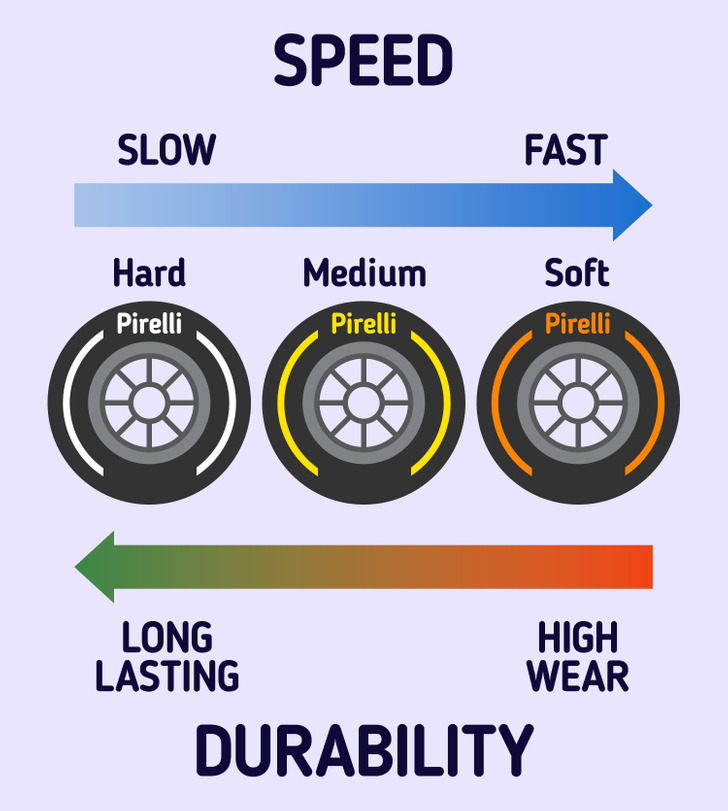
Formula One tires are built to last between 60 to 120 km (40 to 80 miles). The only supplier for Formula One is Pirelli and the tires are rated from C1 (the hardest) to C5 (the softest):
- C1: the hardest tire, it takes longer to warm up but is highly durable so it is designed for the circuits that put a lot of stress on the tires (like the ones with fast corners, abrasive surfaces, or high ambient temperatures)
- C2: also a hard tire, but versatile as it can adapt to different circuits.
- C3: a medium, that has a good balance between durability and performance. It is one of the most used ones.
- C4: can quickly warm up and has high performance but can wear out fast too. Works well on circuits that are narrow and twisty.
- C5: hyper-soft and the fastest one. It’s suitable for all circuits but has the shortest lifespan.
As already mentioned, teams have to use at least 2 different tire compounds. Drivers must think of tires as a resource since there are several rules limiting the number and types of sets they can use throughout the weekend. For example, the driver can start a race with a soft tire and finish the race on a medium. They can also use all 3, but that mostly depends on the team’s race strategy and the circuit.
Note: there are also 2 types of tires that are designed for wet tracks, in case there is rainy weather — intermediate and wet tires.
Pit stop
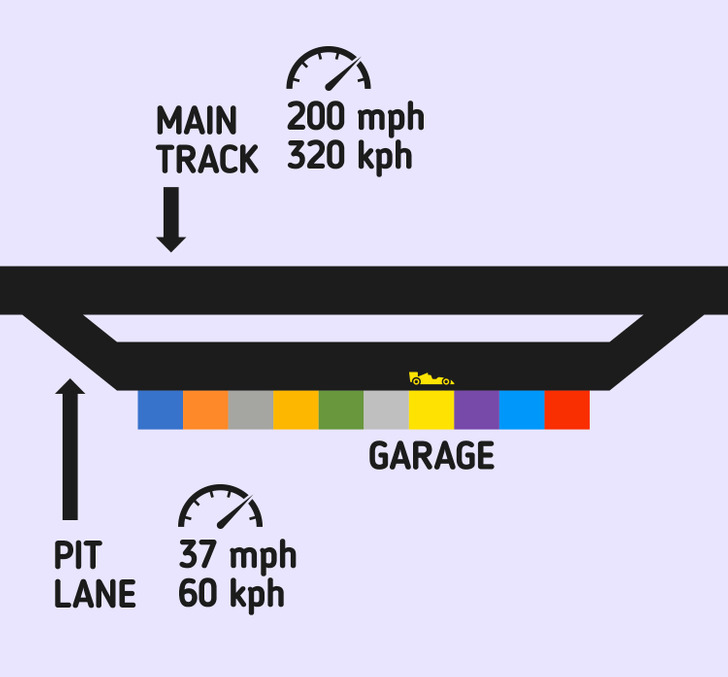
Pits are based on the side of the racing lane, they are assigned to each team and the order depends on the qualifying rankings. They are important for the drivers, as those are the places where they can change their tires and make repairs or adjustments to the cars. As stated before, contestants need to make at least one stop because tires are not designed to last throughout the whole race, so they have to be changed.
There is a limited speed at which the drivers can go thru the pit lane and it is 60 kph (37 mph). Also, changing tires requires time, so all of this needs to be taken into account when creating a race strategy.
Flags
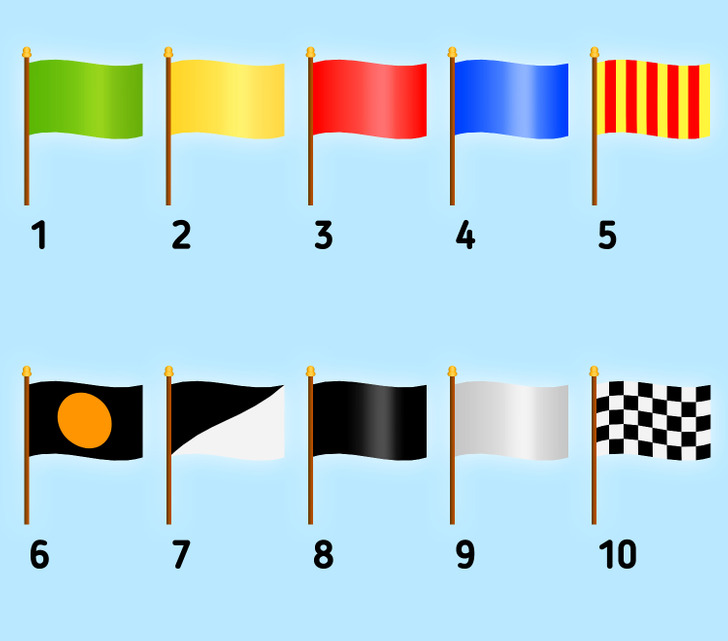
Flags are used to send messages during the race, and here is what each color means:
- Green: indicates the start of the race (or the restart if there was a temporary delay).
- Yellow: warns the driver to go slow in case of an accident, due to rain, or if there is a crash, debris, or even an animal on the track. Single-waved yellow flag means that the cars can’t overtake because there is a danger on the track. Double-waved yellow flag means that the track is blocked so, again, no overtaking is allowed.
- Red: used as a warning sign and signals to driver to stop or return to the pit immediately.
- Blue: means that the driver in front is one or 2 laps down and must let faster cars behind pass them.
- Yellow and red stripe: informs the driver that conditions of the track are changed by car debris or oil and could cause problems, like loss of control or reduced grip.
- Black with an orange circle: signals that the car has a mechanical problem and the driver must return to the garage.
- Black and white: this black flag with a diagonally split white part warns the driver about receiving a penalty for unsportsmanlike behavior.
- Black: means that the driver is disqualified and must immediately return to the pit.
- White: is waived at the end of the free practice sessions, or when a slower moving car is ahead. This flag is also used when a medical vehicle, like an ambulance, is on the track.
- Checkered: is waived once the race is finished. The drivers cannot start a new lap but they can finish the current one.
Bonus: Teams and tracks for the 2022 season
